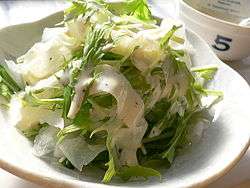Mizuna

Mizuna (ミズナ(水菜)?, "water greens") , shui cai, kyona,[1] Japanese mustard, potherb mustard, Japanese greens, California peppergrass, or spider mustard, is a cultivated crop plant from the species Brassica rapa, subspecies nipposinica.[1]
Description and use

The taste of mizuna has been described as a "piquant, mild peppery flavor...slightly spicy, but less so than arugula."[2] It is also used in stir-fries, soups, and nabemono (Japanese hot pots).
A seller of packaged seeds in the United Kingdom describes mizuna as:
A vigorous grower producing numerous stalks bearing dark green, deeply cut and fringed leaves. They have a fresh, crisp taste and can be used on their own or cooked with meat. The Japanese are fond of them pickled. Highly resistant to cold and grown extensively during the winter months in Japan.— [3]
According to the BBC:
Not only is it good to eat, it's also quite decorative, with glossy, serrated, dark green leaves and narrow white stalks, looking good in flower beds and as edging. It's vigorous, adaptable and easy to grow in most soils. Mizuna greens have a mild mustard plant flavour. The usual sowing time, outside, is from early to late summer, but it can be sown in late spring or early summer, when it may have a tendency to bolt. Another alternative, is to sow in early autumn, for transplanting under cover.— [4]
An online recipe site says:
...this vegetable averages 14" to 16" in height with leaves that are green and yellow, smooth in texture and somewhat feathery in shape. It is available as a mature green or as a baby version that is smaller in size and more tender in texture. As a salad green mizuna can be steamed, boiled, stir-fried or used to complement other greens mixed together for a salad, especially Red Asian Mustard greens. When cooked it shrinks to about half its size so it takes a large amount to make a cooked vegetable dish containing only mizuna. Mizuna can be found in well-stocked grocery stores or produce markets but is most readily available in early spring to late summer. Select fresh crisp leaves, avoiding those that are slightly discolored. They will keep four to five days when wrapped in plastic and stored in the vegetable drawer of the refrigerator.— [5]
Varieties
In addition to the term "mizuna" (and its alternates) being applied to at least two different species of Brassica, horticulturalists have defined and named a number of varieties. For example, a resource provided by Cornell University and the United States Department of Agriculture lists sixteen varieties including "Early Mizuna", "Kyona Mizuna", "Komatsuna Mizuna", "Vitamin Green Mizuna", "Kyoto Mizuna", "Happy Rich Mizuna", "Summer Fest Mizuna", "Tokyo Early Mizuna", "Mibuna Mizuna", "Red Komatsuna Mizuna", "Waido Mizuna" and "Purple Mizuna".[6]
Cultivation
Mizuna has been cultivated in Japan since ancient times.
References
- 1 2 USDA GRIN Taxonomy, retrieved 18 November 2016
- ↑ Discovering Mizuna
- ↑ Chiltern Seeds
- ↑ BBC Gardening
- ↑ RecipeTips.com
- ↑ Vegetable Varieties for Gardenders
External links
- PROTAbase on Brassica rapa
- "Brassica rapa". Integrated Taxonomic Information System. Retrieved 17 November 2006.
